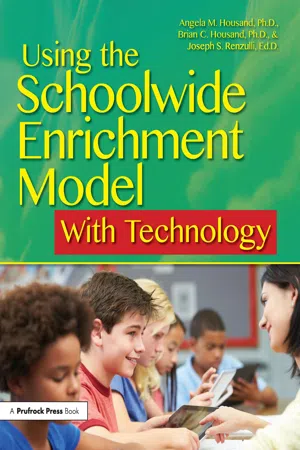
Using the Schoolwide Enrichment Model With Technology
Angela M. Housand, Brian C. Housand, Joseph S. Renzulli
- 292 páginas
- English
- ePUB (apto para móviles)
- Disponible en iOS y Android
Using the Schoolwide Enrichment Model With Technology
Angela M. Housand, Brian C. Housand, Joseph S. Renzulli
Información del libro
Using the Schoolwide Enrichment Model With Technology is an extension of a talent development model implemented in more than 2, 500 schools across the U.S. and widely used internationally. More than 40 years of research and development have documented the effectiveness of the SEM approach to promoting higher level thinking skills and creative productivity. This solution-oriented book, unlike other books focused on using technology in the classroom, recognizes that digital technologies are changing and evolving at lightning speeds. Our effective skills for using technology transcend time by focusing on how to find and use digital resources and tools rather than listing the resources that already exist. Focusing on the skills that support critical thinking and problem solving, decision making, and communication, the authors seamlessly merge technology to launch students toward independent productivity. This accessible and highly practical guide is rich with examples that will change the way you think about education while providing hands-on "how-to" guidance for creating a culture of excellence and innovation in your school and classroom.
Preguntas frecuentes
Información
PART 1 Getting Started
CHAPTER 1 The Schoolwide Enrichment Model (SEM)
Introduction
- maintain and expand a continuum of special services that will challenge students with demonstrated superior performance or the potential for superior performance in any and all aspects of the school and extracurricular program;
- infuse into the general education program a broad range of activities for high-end learning that will challenge all students to perform at advanced levels, and allow teachers to determine which students should be given extended opportunities, resources, and encouragement in particular areas where superior interest and performance are demonstrated; and
- preserve and protect the positions of gifted education specialists and any other specialized personnel necessary for carrying out these goals.
The SEM Identifies Potential and Talent

The Total Talent Portfolio
- collect information about students' strengths on a regular basis;
- classify this information into the general categories of abilities, interests, and learning styles;
- periodically review and analyze the information in order to make decisions about providing opportunities for enrichment experiences in the general education classroom, the enrichment clusters, and the continuum of special services; and
- use this information to make decisions about acceleration and enrichment in school and in later educational, personal, and career decisions.
Curriculum Modification and Differentiation Techniques

Enrichment Learning and Teaching
- Each learner is unique, and therefore, all learning experiences must be examined in ways that take into account the abilities, interests, and learning styles of the individual.
- Learning is more effective when students enjoy what they are doing, and therefore, learning experiences should be constructed and assessed with as much concern for enjoyment as for other goals.
- Learning is more meaningful and enjoyable when content (i.e., knowledge) and process (i.e., thinking skills, methods of inquiry) are learned within the context of a real and present problem; and therefore, attention should be given to opportunities to personalize student choice in problem selection, the relevance of the problem for individual students at the time the problem is being addressed, and authentic strategies for addressing the problem.
- Some formal instruction may be used in enrichment learning and teaching, but a major goal of this approach to learning is to enhance knowledge and thinking skill acquisition that is gained through formal instruction with applications of knowledge and skills that result from students’ own construction of meaning (Renzulli, 1994).
School Structures of the SEM
Th...
Índice
- Cover Page
- Half Title Page
- Title Page
- Copyright Page
- Table of Contents Page
- Part I: Getting Started
- Part II: Technology Enhancements for the Enrichment Triad Model
- Part III: Putting the Pieces Together
- Appendix A Taxonomy of Type II Enrichment Process Skills
- Appendix B SEM: Tech Templates
- References
- About the Authors